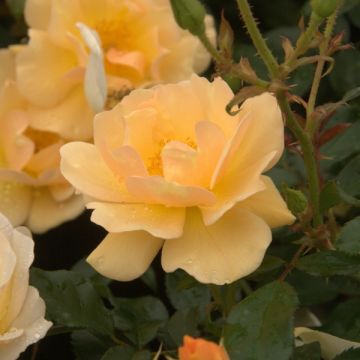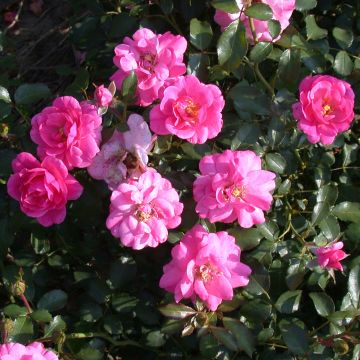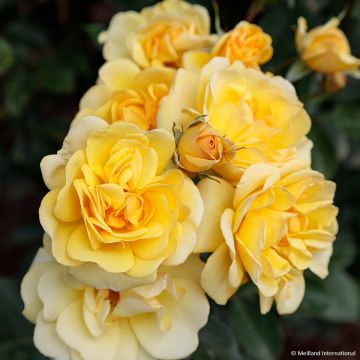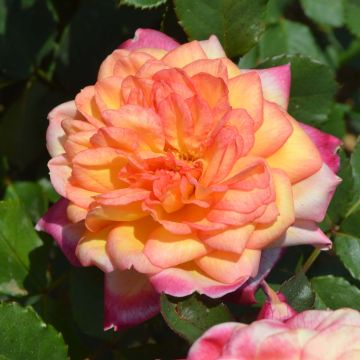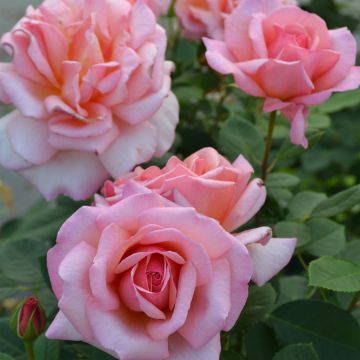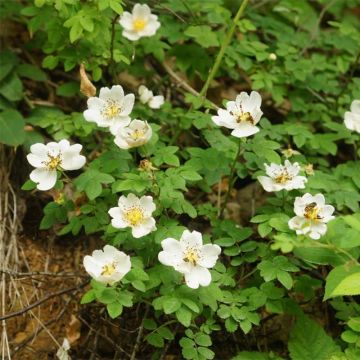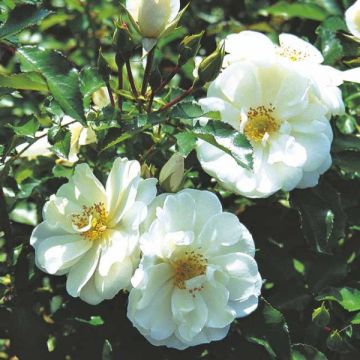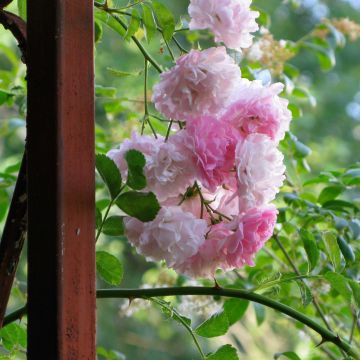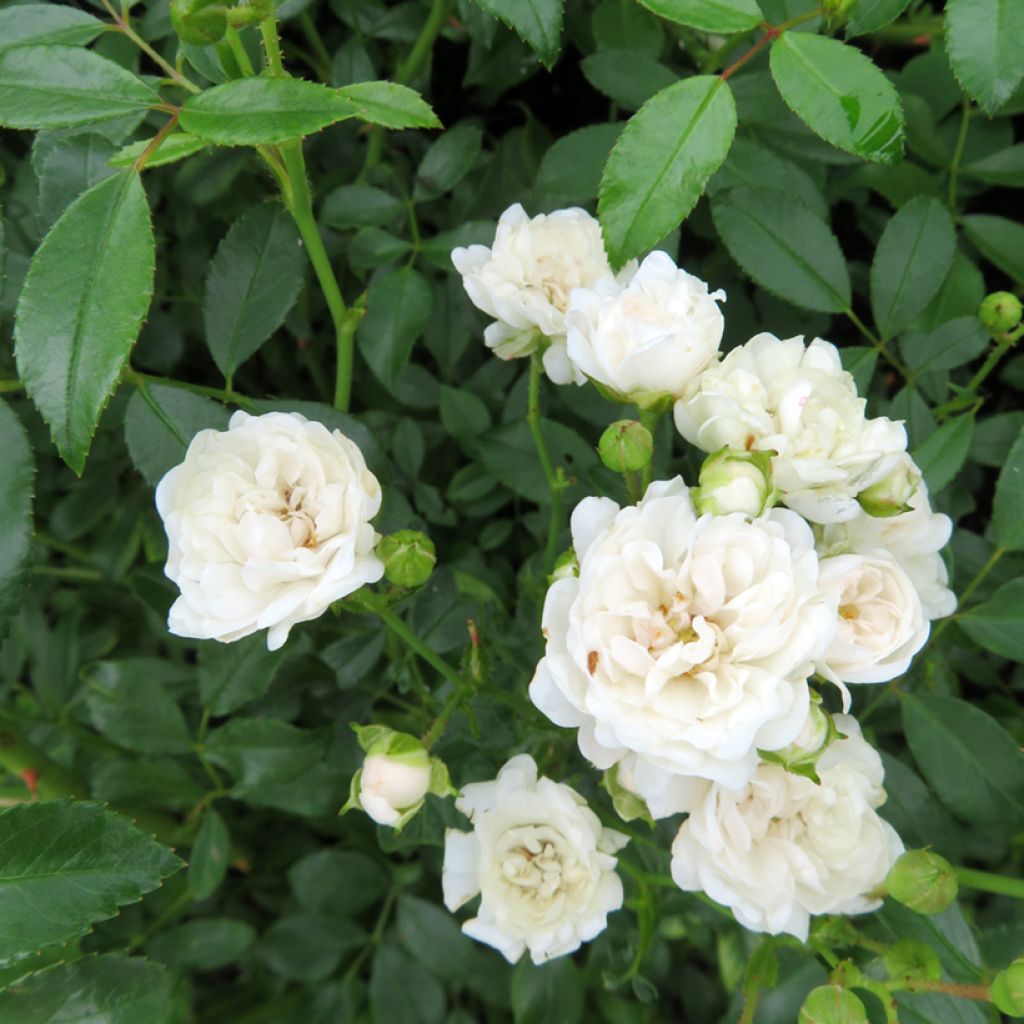

Rosa Sea Foam - Groundcover Rose
Rosa Sea Foam - Groundcover Rose
Rosa x wichurana Sea Foam
Ground Cover Rose, Landscape Rose, Polyantha Rose
This item cannot be shipped to the selected country
Delivery charge from €5.90
Delivery to Corse prohibited
More information
Schedule delivery date,
and select date in basket
This plant carries a 24 months recovery warranty
More information
We guarantee the quality of our plants for a full growing cycle, and will replace at our expense any plant that fails to recover under normal climatic and planting conditions.
From €5.90 for pickup delivery and €6.90 for home delivery
Express home delivery from €8.90.
Delivery to Corse prohibited: UE law prohibits the import of this plant from mainland France to Corse as part of the fight against Xylella fastidiosa. Please accept our sincere apologies.
More information
Does this plant fit my garden?
Set up your Plantfit profile →
Description
The 'Sea Foam' rose bush is a vigorous, charming landscape or ground cover. It seduces with vigour, good health, and almost frothy white flowering. With a spreading habit, this bush produces bouquets of white rosettes, slightly pinker in the centre, with a light fragrance. They bloom on elegant, shiny, dark green foliage. Resistant to diseases, it requires little attention and care from the gardener, even for beginners. This unparalleled rose bush works wonders in front of taller shrubs, in large borders, along pathways... It tolerates heat and partial shade!
The 'Sea Foam' rose bush is a creation by Schwartz (U.S.A) dating back to 1964. It results from cross-breeding between the climbing rose 'White New Dawn' and 'Pinocchio'. The tiny flowers of 'Sea Foam' are gathered in terminal clusters. This small bush has a spreading and very flexible bushy habit, wider than it is tall. It will reach approximately 1m in height with a spread of 1.50m in a few years. The double flowers, 4cm in diameter, with 35 petals, have a pompom shape. They are abundantly produced in May-June and again from September to October. If the soil remains moist in July-August, the bush can produce another wave of flowers. Their colour, predominantly white, turns cream-pink in the centre as the hours pass. This vigorous variety develops elegant deciduous foliage that is well-filled and composed of small, shiny, dark green leaves. They are not very susceptible to diseases under good growing conditions. Its long, flexible stems are thorny.
The 'Sea Foam' rose bush adapts to all soils that are not too dry and all climates, which allows it to be welcomed without reservation in many regions. It works wonders as a border, in a flower bed, or on a large slope where it will cover the ground. It can also be planted in groups of 3 plants, arranged in a triangle, or as a standalone on a lawn. Plant it in mass or in combination with the roses 'The Fairy' and 'Astronomia', two excellent pink landscape ground cover roses. It can also highlight the layout of a pathway or borders composed of taller shrubs.
Report an error about the product description
Plant habit
Flowering
Foliage
Botanical data
Rosa
x wichurana
Sea Foam
Rosaceae
Ground Cover Rose, Landscape Rose, Polyantha Rose
Cultivar or hybrid
Other Ground Cover and Dwarf Roses
Planting and care
The 'Sea Foam' rose prefers a sunny location (at least 4 to 5 hours of sun per day), but it tolerates partial shade well in warmer climates. Roses appreciate loose, permeable, and rich soil. They adapt to any garden if the soil is well-worked and sufficiently rich. To plant your rose in a pot, prepare the soil in a 30 cm cube by crumbling the soil and adding a bottom amendment such as blood, fish and bone. Position your plant, remove it from its pot, cover the top of the root ball with 3 cm of soil, fill the hole, and water generously to eliminate air pockets. In dry weather, it is necessary to water regularly for a few weeks to facilitate root growth. Also, remember to provide your rose with special rose fertiliser that stimulates flowering in plants.
Roses are often stained or unsightly at the end of summer, but this is not a problem for their development. These spots are not harmful to the rose but are natural.
Planting period
Intended location
Care
-
, onOrder confirmed
Reply from on Promesse de fleurs
Roses by purpose
Haven't found what you were looking for?
Hardiness is the lowest winter temperature a plant can endure without suffering serious damage or even dying. However, hardiness is affected by location (a sheltered area, such as a patio), protection (winter cover) and soil type (hardiness is improved by well-drained soil).

Photo Sharing Terms & Conditions
In order to encourage gardeners to interact and share their experiences, Promesse de fleurs offers various media enabling content to be uploaded onto its Site - in particular via the ‘Photo sharing’ module.
The User agrees to refrain from:
- Posting any content that is illegal, prejudicial, insulting, racist, inciteful to hatred, revisionist, contrary to public decency, that infringes on privacy or on the privacy rights of third parties, in particular the publicity rights of persons and goods, intellectual property rights, or the right to privacy.
- Submitting content on behalf of a third party;
- Impersonate the identity of a third party and/or publish any personal information about a third party;
In general, the User undertakes to refrain from any unethical behaviour.
All Content (in particular text, comments, files, images, photos, videos, creative works, etc.), which may be subject to property or intellectual property rights, image or other private rights, shall remain the property of the User, subject to the limited rights granted by the terms of the licence granted by Promesse de fleurs as stated below. Users are at liberty to publish or not to publish such Content on the Site, notably via the ‘Photo Sharing’ facility, and accept that this Content shall be made public and freely accessible, notably on the Internet.
Users further acknowledge, undertake to have ,and guarantee that they hold all necessary rights and permissions to publish such material on the Site, in particular with regard to the legislation in force pertaining to any privacy, property, intellectual property, image, or contractual rights, or rights of any other nature. By publishing such Content on the Site, Users acknowledge accepting full liability as publishers of the Content within the meaning of the law, and grant Promesse de fleurs, free of charge, an inclusive, worldwide licence for the said Content for the entire duration of its publication, including all reproduction, representation, up/downloading, displaying, performing, transmission, and storage rights.
Users also grant permission for their name to be linked to the Content and accept that this link may not always be made available.
By engaging in posting material, Users consent to their Content becoming automatically accessible on the Internet, in particular on other sites and/or blogs and/or web pages of the Promesse de fleurs site, including in particular social pages and the Promesse de fleurs catalogue.
Users may secure the removal of entrusted content free of charge by issuing a simple request via our contact form.
The flowering period indicated on our website applies to countries and regions located in USDA zone 8 (France, the United Kingdom, Ireland, the Netherlands, etc.)
It will vary according to where you live:
- In zones 9 to 10 (Italy, Spain, Greece, etc.), flowering will occur about 2 to 4 weeks earlier.
- In zones 6 to 7 (Germany, Poland, Slovenia, and lower mountainous regions), flowering will be delayed by 2 to 3 weeks.
- In zone 5 (Central Europe, Scandinavia), blooming will be delayed by 3 to 5 weeks.
In temperate climates, pruning of spring-flowering shrubs (forsythia, spireas, etc.) should be done just after flowering.
Pruning of summer-flowering shrubs (Indian Lilac, Perovskia, etc.) can be done in winter or spring.
In cold regions as well as with frost-sensitive plants, avoid pruning too early when severe frosts may still occur.
The planting period indicated on our website applies to countries and regions located in USDA zone 8 (France, United Kingdom, Ireland, Netherlands).
It will vary according to where you live:
- In Mediterranean zones (Marseille, Madrid, Milan, etc.), autumn and winter are the best planting periods.
- In continental zones (Strasbourg, Munich, Vienna, etc.), delay planting by 2 to 3 weeks in spring and bring it forward by 2 to 4 weeks in autumn.
- In mountainous regions (the Alps, Pyrenees, Carpathians, etc.), it is best to plant in late spring (May-June) or late summer (August-September).
The harvesting period indicated on our website applies to countries and regions in USDA zone 8 (France, England, Ireland, the Netherlands).
In colder areas (Scandinavia, Poland, Austria...) fruit and vegetable harvests are likely to be delayed by 3-4 weeks.
In warmer areas (Italy, Spain, Greece, etc.), harvesting will probably take place earlier, depending on weather conditions.
The sowing periods indicated on our website apply to countries and regions within USDA Zone 8 (France, UK, Ireland, Netherlands).
In colder areas (Scandinavia, Poland, Austria...), delay any outdoor sowing by 3-4 weeks, or sow under glass.
In warmer climes (Italy, Spain, Greece, etc.), bring outdoor sowing forward by a few weeks.

































